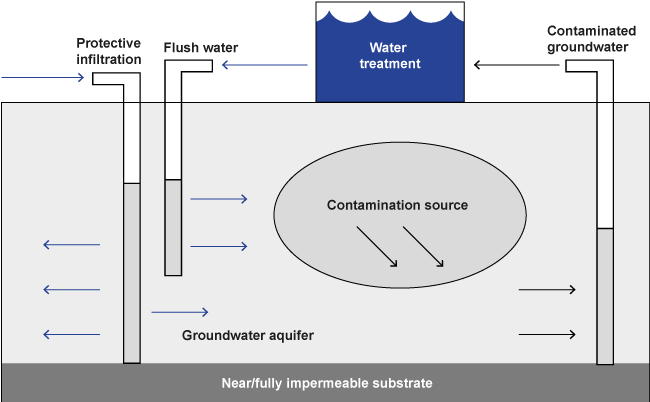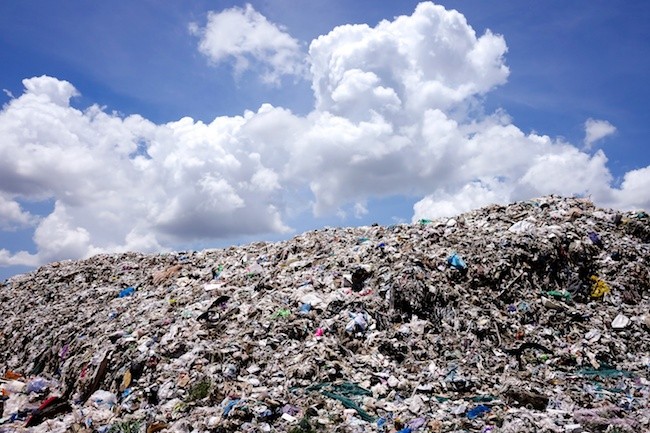Whether it be old landfills, coal tips, former military sites or refineries, what remains behind is contaminated ground, which is a danger to both humans and the environment. In the rehabilitation of these sites, level sensors are required which are resistant to the often aggressive hazardous substances encountered.
Contaminated sites are not only characterized by adverse health or environmental changes in the soil. In the absence of safety measures (as in old landfills) and depending on soil conditions, hazardous substances are flushed by rain into the groundwater. Depending on the type of usage, a number of different hazardous substances can be found, including, among others:
- Heavy-metal compounds: Copper, lead, chromium, nickel, zinc and arsenic (a metalloid)
- Organic materials: Phenols, mineral oil, benzenes, chlorinated hydrocarbons (CHC), aromatic hydrocarbons (PAH)
- Salts: Chlorides, sulfates, carbonates
Decontamination of the groundwater supply
In the rehabilitation of contaminated sites, not only is cleansing of the soil of great importance, but also the control and purification of the groundwater. Without reliable level sensors that can withstand the adverse conditions, this would not be possible.
The decontamination process usually proceeds as follows: The contaminated groundwater is pumped to the surface and then treated. As filtered flush water, it is next returned to the source of contamination. To prevent this flush water from flowing to a margin away from the contamination source, active hydraulic methods are used for protective infiltration. Water is injected into the ground via several wells situated around the actual decontamination process. The pressure conditions arising here to some extent form a barrier wall and cause the flush water to flow towards the source of contamination. For controlling and monitoring this process, level sensors will be required.

Figure 1: Flow of a decontamination process
Level sensors are of course also used after the remediation work. Long after completion of this work, the affected sites will be monitored to check for any noticeable changes in the water level or the direction of flow.
Level sensors are also used when actively running applications potentially damaging to the environment. Newer landfills are now built like an impermeable basin. The groundwater level below the landfill is lowered, so that no water can flow into adjacent areas in the event of leakage. Here also, the respective water levels are to be monitored by level sensors.
Level sensors in contaminated waters: Highest demands
Operators in the field of decontamination of polluted sites should be very careful in choosing suitable level sensors. Due to the large number of substances that can be dissolved in the water, there is no single solution that works reliably in every instance. There are several aspects to consider, which we next briefly outline.
Materials
Housing
In most applications, a high-quality stainless steel, as used by STS, is sufficient to protect the measuring cell from aggressive substances. If this were to come in contact with saltwater, then a titanium housing would be chosen, but where galvanic effects are to be expected, a level sensor made of PVDF should be the selection.

Figure 2: ATM/NC chemically resistant level sensor with PVDF housing
Probe cable
Far more critical than choosing a suitable housing, in our experience, is the choice of probe cable. Because of gradual diffusion processes, the progress of destruction is not immediately apparent. Often, this is not visible from the outside even when already damaged. Special caution is therefore required when consulting resistance tables, since these usually say little in particular about probe cables. In the middle of a probe cable is a small air tube, which serves for relative pressure equalization. If the cable material is not one hundred percent resistant, however, raw materials may diffuse through the cable sheath and travel across the air tube into the sensor chip.
Depending upon the substances anticipated, STS users can resort to PE, PUR or FEP cables. The latter can also be used at very high temperatures of up to 110 °C.
Installation
Cable routing
Old landfills and industrial sites are harsh environments, where not only hazardous substances can impair the functionality of the level sensors used. Care must be taken that the cable sheath is not damaged by mechanical burdens (such as debris). Chafing and kinking points should also be avoided. It is therefore recommended to use special protective tubes, such as those offered by STS, when routing cables.
Strain relief
The compression rating of level sensors varies from manufacturer to manufacturer. At STS, all level sensors are pressure-resistant up to 250 meters as standard and their cable is designed for normal tensile strains up to this depth. Nevertheless, operators should consider the use of strain relief in difficult installation conditions.
Mounting
If the sensor is used in flowing waters or tanks with agitators, it can be supplied either with a G 1/2” thread at the cable outlet (pipe mounting) or with a compression fitting (15 mm).
Explosion protection
In applications where a number of hazardous substances are to be expected, it is imperative to also pay attention to explosion protection. Information about this is given by the international standards-compliant ATEX directive.
